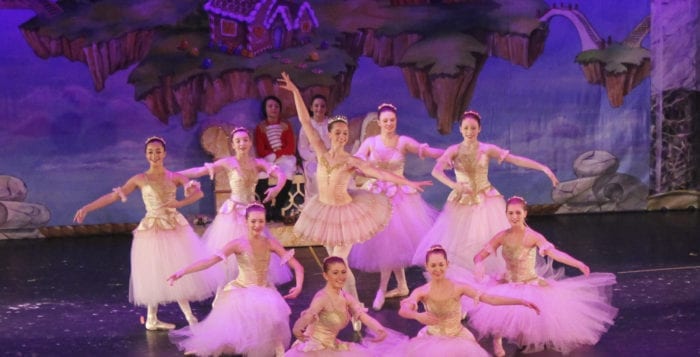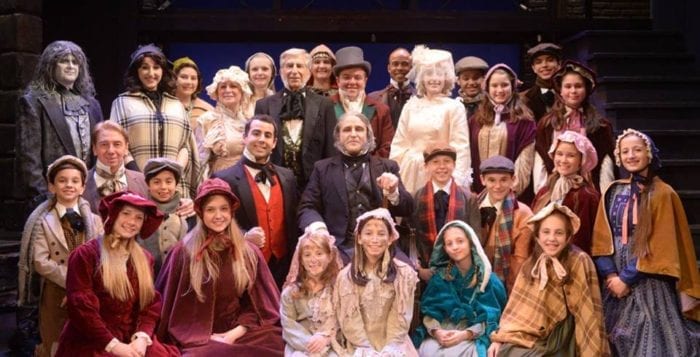 Attention coffee lovers! Village Coffee Market, 131 Main St., Stony Brook (located right next to the post office) invites the community to an Open House on Tuesday, Nov. 29 from 5:30 to 7:30 p.m. Come find out all about the newest store at the Stony Brook Village Center. Start your holiday shopping while enjoying coffee samples and baked goods. For additional questions, call 631-675-9525.
Attention coffee lovers! Village Coffee Market, 131 Main St., Stony Brook (located right next to the post office) invites the community to an Open House on Tuesday, Nov. 29 from 5:30 to 7:30 p.m. Come find out all about the newest store at the Stony Brook Village Center. Start your holiday shopping while enjoying coffee samples and baked goods. For additional questions, call 631-675-9525.
Yearly Archives: 2016
BNL’s Yoo uses machine learning to climb mountains of data
By Daniel Dunaief
He works with clouds, solar radiation and nanoparticles, just to name a few. The subjects Shinjae Yoo, a computational scientist at Brookhaven National Laboratory, tackles span a broad range of arenas, primarily because his focus is using large pieces of information and making sense of them.
Yoo helps refine and make sense of searches. He develops big data streaming algorithms that can apply to any domain where data scalability issues arise. Integrating text analysis with social network analysis, Yoo did his doctoral research at Carnegie Mellon University, where he also earned a master’s degree, on creating systems that helped prioritize these electronic messages.
“If you are [traveling and] in the airport, before you get into your plane, you want to check your email and you don’t have much time,” he said. While this isn’t the main research work he is doing at the lab, this is the type of application for his work. Yoo developed his technical background on machine learning when he was at Carnegie Mellon. He said he continues to learn, improve and develop machine learning methods in various science domains. By using a statistical method that combines computational science skills, statistics and applied math, he can offer a comprehensive and, in some cases, rapid analysis of information.
Colleagues and collaborators suggested Yoo has made an impact with his work in a wide range of fields. His “contribution is not only in the academic field, but also means a lot on the industrial and academic field,” Hao Huang, a machine learning scientist at GE Global Research, wrote in an email. “He always focuses on making good use of data mining and machine learning theory on real world [areas] such as biology, renewable energy and [in the] material science domain.”
Yoo explained how a plant biologist can do stress conditioning for a plant with one goal in mind. That scientist can collect data over the course of 20 years and then they can “crunch the data, but they can’t always analyze it,” which might be too unwieldy for a bench scientist to handle. Using research from numerous experiments, scientists can study the data, which can provide a new hypothesis. Exploring the information in greater detail, and with increased samples, can also lead to suggestions for the best way to design future experiments.
Yoo said he can come to the scientist and use machine learning to help “solve their science data problem,” giving the researchers a clearer understanding of the broad range of information they collected. “Nowadays, generated data is very easy,” but understanding and interpreting that information presents bigger challenges. Take the National Synchrotron Light Source II at BNL. The $912 million facility, which went live online earlier this year, holds considerable promise for future research. It can look at the molecules in a battery as the battery is functioning, offering a better understanding of why some batteries last considerably longer than others. It can also offer a look at the molecular intermediaries in biochemical reactions, offering a clearer and detailed picture of the steps in processes that might have relevance for disease, drug interactions or even the creation of biological products like shells. He usually helps automate data analytics or bring new hypotheses to scientists, Yoo said. One of the many challenges in experiments at facilities like the NSLS II and the Center for Functional Nanomaterials, also at BNL, is managing the enormous flow of information that comes through these experiments.
Indeed, at the CFN, the transmission electron microscopy generates 3 gigabytes per second for the image stream. Using streaming analysis, he can provide an approximate understanding of the information. Yoo received a $1.9 million, three-year Advanced Scientific Computer Research grant this year. The grant is a joint proposal for which Yoo is the principal investigator. This grant, which launched this September, is about high-performance computing enabled machine learning for spatio-temporal data analysis. The primary application, he said, is in climate. He plans to extend it to other data later, including, possibly for NSLS II experiments.
Yoo finds collaborators through emails, phone calls, seminars or anywhere he meets other researchers. Huang, who started working with Yoo in 2010 when Huang was a doctoral candidate at Stony Brook, appreciates Yoo’s passion for his work. Yoo is “dedicated to his research,” Huang explained. “When we [ran] our proposed methods and got results that [were] better than any of the existing work, he was never satisfied and [was] always trying to further explore to get even better performance.”
When he works with collaborators in many disparate fields, he has found that the fundamental data analysis methodologies are similar. He needs to do some customization and varied preprocessing steps. There are also domain-specific terms. When Yoo came to BNL seven years ago, some of his scientific colleagues around the country were not eager to embrace his approach to sorting and understanding large pools of data. Now, he said other researchers have heard about machine learning and what artificial intelligence can do and they are eager to “apply those methods and publish new papers.”
Born and raised in South Korea, Yoo is married to Hayan Lee, who earned her PhD at Stony Brook and studies computational biology and specializes in genome assembly. They have a four-year old son, Erum. Yoo calls his son “his great joy” and said he “gives me a lot of happiness. Hanging around my son is a great gift.”
When Yoo was entering college in South Korea, he said his father, who had worked at the National Institute of Forest Science, played an important role. After his father consulted with people about different fields, he suggested Yoo choose computer science over chemistry, which would have been his first choice. “He concluded that computer science would be a new field that would have a great future, which is true, and I appreciate my dad’s suggestion,” Yoo said.
Harbor Ballet Theatre’s ‘The Nutracker’ turns 25
By Kevin Redding
Toy soldiers, angels, sword-wielding mice and a sugar plum fairy are back in town to spread the magic of Christmas to audiences young and old.
For more than two decades, the North Shore community has looked to Port Jefferson’s Harbor Ballet Theatre to officially kick off the holiday season each year with its dazzling production of Tchaikovsky’s “The Nutcracker.”Coming up on its 25th anniversary production, the not-for-profit dance company gears up to deliver another unforgettable spectacle. John Worrell, executive artistic director of the show, said that the calibre of their production has helped it become a holiday tradition among the community.
“The dancing, the dancers, the choreography and the sets are incredible,” said Worrell. “Just the way that we tell the story is very understandable and very easy for everyone to follow. It really sets the tone for Port Jefferson and Setauket and Stony Brook and Miller Place because everybody gravitates to get that holiday feeling.”
Harbor Ballet Theatre was founded in 1991 by Worrell and his wife Amy Tyler as an open company to give dancers of all ages the opportunity to be part of professionally staged ballet productions. Worrell said it was also created to allow anybody from anywhere to come and audition, which is why there are so many new faces on a year-to-year basis as well as longtime dancers.
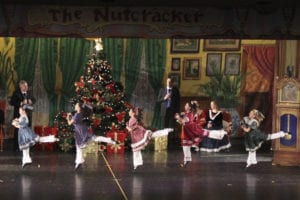
This production will feature about 70 performers, a majority of them between the ages 6 and 25. Auditions were held in the second week of September and the first rehearsal took place on the first weekend of October, giving way to 10 to 12 strenuous yet worthwhile rehearsals before the final show. Some of the senior dancers in the show even committed six to seven days a week for at least two hours a day to rehearsal.
“That whole debate whether dance is a sport … they [dancers] train like athletes,” said Worrell. “They work drills everyday. To be able to get to the level they want to be and be able to do their solos in the second act and lift each other up, they have to work their butts off.”
Richard Liebert and Rebecca Stafford, seniors from Earl L. Vandermuellen High School, are among some of the more experienced dancers in the production. Liebert, who plays the Mouse King, said there are a lot of physical challenges.
“There are times [in the show] where I have to lift a girl over my head and turn her,” said Liebert. “It could be a bit intimidating … but it’s worthwhile. I love doing it.”
“We’re with our friends, so we’re having fun,” said Stafford, who plays Harlequin.
Worrell said that at the start of production, he and Amy watched the DVD from the previous year’s show and figured out what, if anything, they wanted to change. The most common changes year-to-year have to do with solos, which depend on the dancers in the show, what their strengths are, and what they feel most comfortable doing.
Worrell said that there are plans to add a new element this year but wants to keep it a surprise and “make sure that it works first.”“We try to add something new every year, every two years … just to keep it fresh, so the audience will find it fun to watch,” he said.
Join Harbor Ballet Theatre in celebrating its 25th anniversary of “The Nutcracker” and prepare to be swept away by the extravagant sets, rich costumes, passionate acting and dancing and Tchaikovsky’s masterful music.
Performances of “The Nutcracker” will be held on Friday, Dec. 2, at 8 p.m., Saturday, Dec. 3, at 3 and 8 p.m. and Sunday, Dec. 4, at 3 p.m. at Earl L. Vandermuellen High School, 350 Old Post Road, Port Jefferson. All seats are $25 in advance, cash or check only. For more information, please call 631-331-3149.
‘Mary Poppins’ is the spoonful of sugar we all need right now

By Melissa Arnold
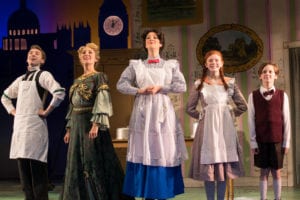
Sometimes, looking at life through a child’s eyes again makes everything better.
That’s exactly the opportunity you’re given in “Mary Poppins,” which kicked off a six-week run at the John Engeman Theater in Northport this week. And boy, is it a treat.
The Engeman Theater has a reputation for pulling out all the stops for its shows, and “Mary Poppins” definitely reaps those benefits with a stunning, colorful background, detailed scenery and a cast of seasoned professionals, many of whom spent time on Broadway.
Directed and choreographed by Drew Humphrey, this show is a Disney classic, with all the heartwarming moments and magical touches you’d expect. Set in early 1900s London, “Mary Poppins” gives a glimpse into the lives of the wealthy Banks family — workaholic husband George, his doting wife Winifred and their adorable-yet-mischievous children, Jane and Michael.
Try as they might, the Bankses can’t seem to find a nanny who will stick around – it might have something to do with the kids’ constant pranks and stubbornness. But Jane and Michael meet their match when Mary Poppins shows up from who knows where. Without any negotiation, she invites herself into their home and begins to work some real magic. Along the way, she introduces them to a host of quirky, mysterious characters that teach them about what’s really important in life.

The story’s unofficial narrator is Bert (Luke Hawkins), a charming chimney sweep with a deep affection for Mary Poppins and the Banks children. Hawkins will have you smiling the minute he takes the stage, and his appearances will tug on your heartstrings throughout the show. His tap dancing skills in “Step in Time” will leave you breathless.
Mary Poppins is played by Analisa Leaming, a newcomer to the Engeman stage with several Broadway credits under her belt. Leamings plays Poppins with all the poise and grace the role demands, with lovely, light vocals even on the highest notes. She also deserves a nod for the slight-of-hand tricks she performs throughout the show, maintaining character even during a rare moment when her props won’t cooperate.
Katherine LaFountain and Christopher McKenna play the Banks children with endless enthusiasm and joy. Both have an obvious love for the stage and there is nothing forced about their performances. You’ll fall in love with them both during “The Perfect Nanny” and “Practically Perfect,” two examples of their fantastic teamwork.
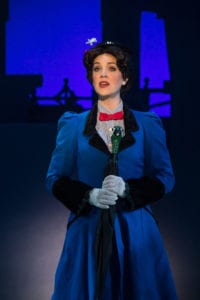
The special effects in “Mary Poppins” are what make the show truly great. Children in the audience might actually believe that Mary’s bag can fit anything, that she can instantly make sandwiches from a loaf of bread, or that she can even fly. Seeing her take flight with that famous umbrella is the highlight of the show.
The show’s set can rotate, expand and retract, which allows for easy transitions between several unique locations. The background is perhaps the most eye-catching element, however, with the London sky in silhouette and a colorful, illuminated sky that can create sunsets, nightscapes and even some psychedelic schemes.
Many of the supporting cast members are also worth a mention. In particular, George Banks’ childhood nanny Miss Andrew (Jane Blass) commands the stage during her brief performance. She has so much swagger and authority that when she’s called “the holy terror,” you’ll believe it in an instant. Also, the “bird woman,” played by Suzanne Mason, delivers a performance of “Feed the Birds” that’s both touching and haunting.
The ensemble has a huge role to play in “Mary Poppins.” Whether they’re seamlessly helping with set changes as chimney sweeps, tap dancing or serving as any number of whimsical creatures, they are an essential part of the show and every bit as talented as the lead actors. In fact, their performance in “Supercalifragilisticexpialadocious” and “Step in Time” are among the most impressive of the entire show. The two children’s ensembles, which will rotate throughout the show’s run, should be commended for their hard work and flawless routines.
While the band isn’t visible or credited at any point in the show, they do a flawless job in presenting songs from the original movie as well as many that were written for the stage version. Under the direction of Michael Hopewell, the band consists of keyboard, bass, drums and a variety of woodwind and brass instruments.
All told, “Mary Poppins” is exactly the joyful, inspiring tale so many of us seek out during the holidays. While it’s not a holiday-themed production, the theater is beautifully decorated for the season, and you can enjoy the occasional Christmas song and a festive drink at the piano bar before showtime.
Take a few hours this holiday season to leave your cares behind and gather the family for a night of laughter. You’ll be glad you did.
The John W. Engeman Theater, 250 Main St., Northport will present “Mary Poppins” through Dec. 31. Run time is approximately 2 hours and 45 minutes with a 15-minute intermission. Ticket prices vary from $71 to $76. To purchase tickets, call 631-261-2900.
Photo of the Week
‘I WILL HONOR CHRISTMAS IN MY HEART’
Above, the 2016 cast of “A Christmas Carol” at Theatre Three gathers for a group photo before opening night last Saturday. The Port Jefferson theater celebrates its 33rd annual production of the immortal classic this holiday season.
Written by Charles Dickens, “A Christmas Carol” was the most successful book of the 1843 holiday season, selling six thousand copies by Christmas. Eight stage adaptations were in production within two months of the book’s publication.
Today, the story of Ebenezer Scrooge and his journey to find the true meaning of Christmas through visits from the ghosts of Christmas past, present and future is as popular as it was over 150 years ago. Charles Dickens, through the voice of Scrooge, continues to urge us to honor Christmas in our hearts and try to keep it all the year.
Send your Photo of the Week to [email protected].
Not a humbug to be had at Theatre Three’s ‘A Christmas Carol’
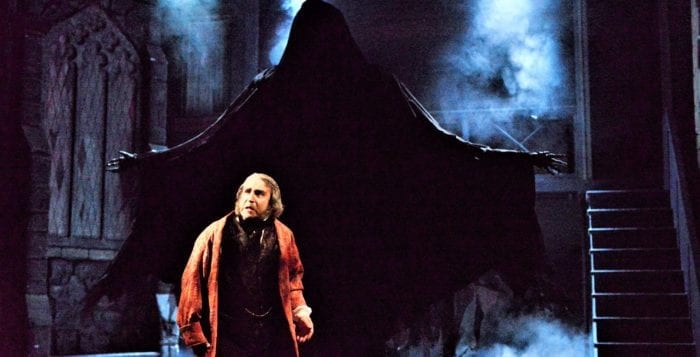
By Michael Tessler

Though the holidays are usually filled with joy, they’re certainly not without their own special breed of stress, which seems to melt away as Theatre Three gifts our community with a profound and magical experience that allows us to escape into the marvelous imaginative world of the late, great Charles Dickens. Theatre Three provides more than just a distraction — it provides unparalleled delights that will stir up the best childlike emotions in each of us.
Jeffrey Sanzel, the show’s director, faces the unique challenge of annually reimagining “A Christmas Carol.” He seamlessly completes this task with his usual grace and confidence. For over 30 years the show has been a must-see tradition for Long Island families and visitors. Sanzel’s vision shines brighter than ever as he masterfully directs his cast. While the story remains the same, its characters are all the more captivating because of the great direction he provides.
What’s most impressive is that not only does Sanzel direct, but he also stars in the iconic role of Ebenezer Scrooge. For those unfamiliar with the classic Dickens novel, Scrooge is a man whose greed supersedes his humanity. One night he is visited by the ghost of his former business partner, Jacob Marley (Steven Uihlein) who informs him that hell awaits him if he doesn’t change his ways. This propels him on an unlikely journey of self-reflection and change.
Sanzel plays not only an older Scrooge, but a younger more lively version of himself. His ability to change physicality and characters instantly is one of his most impressive qualities, and there are plenty!
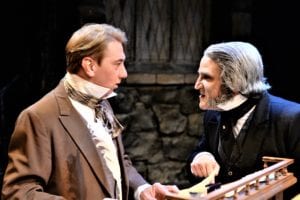
Bob Cratchit, played by the ever-so-gentle Douglas Quattrock, is beyond endearing. There’s a righteousness and goodness about this man that can be felt genuinely by the audience. Cratchit, who works as a clerk for the elderly Mr. Scrooge, endures considerable workplace trauma to make sure his family is fed and taken care of. Despite his hard work, his youngest son, Tiny Tim, remains at the precipice of death. Quattrock will have you grinning cheek to cheek as he embraces his wife played with love by Suzie Dunn and the rest of the family.
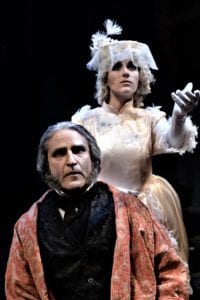
Alongside Cratchit is the kind-hearted and abandoned nephew of Scrooge, Fred Halliwell. There’s a certain glee in Dylan Poulos’ performance. He’s almost infused with the spirit of Christmas itself, which I suppose would make sense as he also plays the Ghost of Christmas Yet to Come! Halliwell seeks nothing more than to rekindle a relationship with his past by getting to know his only living relative, dear Uncle Scrooge. What he doesn’t realize is that his eyes are the same eyes as his departed mother, a painful reminder for old Ebenezer. Fan Scrooge Halliwell (Megan Bush/Sophia Knapp) lives and breathes in certain sequences, and perfectly portrays the love between two close siblings.
Among my favorite cast members is the larger-than-life Fezziwig, played with great fervor by George Liberman. He’s joined alongside his stage wife, played by Ginger Dalton. These two form a comedic pair that will have you smiling as wide as the horizon! There’s something so whimsical about watching Fezziwig’s ball unfold on-stage: the dancing, the singing, everything. Watching you can’t help but feel that you’re up there with them. My favorite part of this sequence is watching the curmudgeon Scrooge transform into a spruce young man who woos and proposes to Fezziwig’s daughter, Belle, played by a belle of extraordinary talent, Emily Gates.
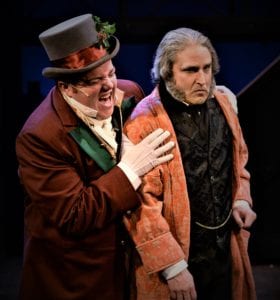
All three spirits are truly splendid. Jessica Contino shines as the Ghost of Christmas Past, bringing Scrooge on a journey that forces him to reconcile many of the mistakes and heartbreaks a long life will bring. Bobby Montaniz nails perfectly the essence of the Ghost of Christmas Present, and while he’s not a giant, his impressive voice certainly sounds like he is! His deep laughter will echo in your belly all through the evening!
Finally the Ghost of Christmas Yet to Come may be the most visually impressive puppetry I’ve seen at Theatre Three yet (and they pulled out an actual dragon for “Shrek!”). This massive and haunting figure must be at least 15 feet tall and is adorned in a black tattered cloak and hood and is perfectly embellished by the brilliant lighting layout by Robert Henderson.
In addition to an incredible cast and superb lighting, this is one of the most beautiful sets I’ve ever seen. There’s a craftsmanship that far exceeds your usual stage show, and not only does it show but genuinely adds to the ambiance of the production. I’ve got nothing but praise for Randall Parsons, the show’s production designer and his costume counterpart Bonnie Vidal.
There are many additional names in the cast and crew who are deserving of praise, especially the incredibly talented children who alternate each night and demonstrate a professionalism and talent well beyond their years. Give yourself and your loved ones a gift that is truly made of magic. Go see “A Christmas Carol.”
Theatre Three, 412 Main St., Port Jefferson will present “A Christmas Carol” through Dec. 31. All tickets are $20 in November and range from $20 to $35 in December. To order, call 631-928-9100 or visit www.theatrethree.com.
SBU’s Harold Walker focuses on clean water
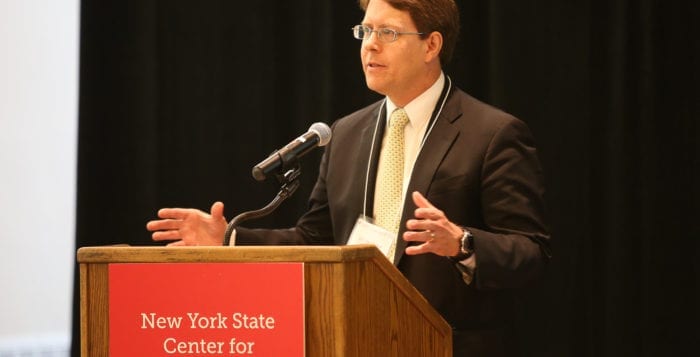
By Daniel Dunaief
Water, water everywhere and Harold “Hal” Walker is making sure there’s more than a few drops on Long Island to drink. The head of the new Department of Civil Engineering at Stony Brook is one of two co-directors of the Center for Clean Water Technology. The center received a $5 million commitment from New York State to pilot test a variety of ways to remove contaminants from drinking water.
“The center will be working with water authorities and water utilities to do pilot testing of new technology to deal with emerging contaminants,” Walker said. “One goal of the testing will be to collect information needed to assess new technologies and, if they are effective, to get them approved so they can be used by water utilities.”
Contaminants the center will explore include 1,4-dioxane and perfluorinated compounds, which have “turned up in some regions of Long Island,” Christopher Gobler, the co-director of the center and an associate dean for research and professor at the School of Marine and Atmospheric Sciences, explained in an email.
’One lesson we have learned is that it is critically important to protect the environment, since the environment serves as a natural buffer to these large storms.’ — Harold Walker
The technologies the center will test likely include novel membrane processes, advanced oxidation, novel absorbents and advanced oxidation processes. The center will explore “how these compounds are removed in conventional drinking water treatments processes,” Walker said. “If they are not removed sufficiently, what do novel technologies use and are they ready for the pilot stage?” Walker acknowledges that staying ahead of the curve in being prepared to protect drinking water requires an awareness of numerous new compounds that are a part of modern manufacturing.
Gobler said the center’s findings would be made public. New York State had previously committed $3.5 million from the Environmental Protection Fund to support the center. With an additional $5 million in funding, the center will develop new technologies to improve drinking water and wastewater quality on Long Island, according to the State Department of Environmental Protection.
The center was formed originally to focus on innovative alternative individual onsite treatment systems for reduction of nitrogen and pathogens. That was broadened this year to focus on the impact of emerging contaminants on water supplies, a representative from the DEC explained in an email.
Walker has built an expertise in developing and applying membrane processes for drinking and wastewater. At Ohio State University, where he worked from 1996 until 2012, when he came to Stony Brook, he spent considerable time analyzing drinking water in the Great Lakes. Gobler appreciates Walker’s expertise.“
He has worked with many federal and state agencies on these topics across the United States,” Gobler explained. “He is also well-versed in wastewater treatment technologies.”
Jennifer Garvey, the associate director for the center, meets with Garvey and Walker at least once a week. She also connects weekly for a call or meeting to discuss administrative and strategic issues. Walker is “at the leading edge of water treatment approaches and he understands where opportunities and obstacles lie,” Garvey said. The center has a sense of urgency about the work because “there is such a clear and immense need for wastewater infrastructure improvements,” she continued. The targeted and strategic work emphasizes near-term solutions. A leading focus is a nonproprietary passive system known as a nitrogen removing biofilter that they will be piloting in Suffolk County soon. “Our hope is that we can make systems available for widespread deployment within the next two to three years,” she said.
Apart from his work at the center, which Walker estimates takes about a third of his time, he is also a professor and the founding chair of the Department of Civil Engineering, which conferred bachelor’s degrees on its inaugural 13 undergraduate students this summer. Those students have all found engineering jobs within their field of interest or continued to pursue additional schooling. The civil engineering department has 10 faculty and is at the end of the first phase of its growth and development, Walker said.
Phase II will include building out the faculty and staff, developing new research and teaching labs and enhancing the recently approved master’s of science and doctoral programs in civil engineering, Walker explained. Resiliency of the coastal communities is a major thrust of his department. He said he recently hired a number of faculty in this area and launched an Advanced Graduate Certificate in Coastal Zone Management and Engineering in partnership with the School of Marine and Atmospheric Sciences. “One lesson we have learned is that it is critically important to protect the environment, since the environment serves as a natural buffer to these large storms,” he explained.
Apart from water and the resilience of the coastal community, the civil engineering department is also involved in transportation. The department works with Farmingdale State College in a new Infrastructure, Transportation and Security Center. In that effort, the department collaborates with the Department of Computer Science, among others at Stony Brook, to bring new approaches to “improving the efficiency, sustainability and safety of our transportation system.”
For his part, Gobler welcomes the talent and expertise the civil engineering department brings to Stony Brook. “This is a tremendous asset” for Stony Brook, Gobler explained in an email. “Civil engineers solve complex problems and I have found that [Walker] and the people he has hired have the skill set and mind-set to address many environmental problems that are important on Long Island.
A resident of Port Jefferson, Walker lives with his wife Alyssa, who is a writer, and their three children, Abby, 14, Halliway, six, and Northie, who is five. They enjoy visiting the beach and traveling east to go apple and pumpkin picking. A native of Southern California, Walker started surfing at the age of 10. He was a four-year varsity letterman in surfing when he was in high school. He has surfed in Hawaii, Costa Rica, Japan, Portugal and Mexico.
As for the department, he said he feels excited by the responsibility for building only the second civil engineering program in the SUNY system. “I’d like the department to quickly become nationally recognized and be the leading source of expertise for the state on infrastructure issues, especially in the downstate area,” he said.
Gardening: Selecting trees for your property
By Ellen Barcel
This is part one of a two-part series.
Selecting trees for your property requires some decision making. For example, which trees do well in acidic soil? Which trees tolerate drought? Which trees are fast (or slow) growers, depending on your needs? Which trees have negatives that may mean you would avoid them (see my columns on researching plants, Sept. 22 and 29). And what about the final height? Is this a specimen tree for the front of your house or a shade tree for your back patio? But, there are other factors involved in your choice. One is evergreen versus deciduous trees. A second is autumn leaf color and a third is final tree shape. Since trees take so long to mature, this is one decision you want to get right.
Evergreen vs. deciduous

Trees can be divided into evergreen and deciduous trees. Evergreen trees keep their needles (leaves) throughout the winter while deciduous ones lose their leaves in fall. Evergreen trees tended to evolve in climates that have short growing seasons. Keeping their needles over the winter is a survival mechanism for the trees since they have greenery ready to feed the tree quickly during that short growing season. Evergreen trees do eventually lose their leaves/needles, but it is later in the growing season after the new ones have come in. Evergreen trees include pine, spruce, cedar, juniper, arborvitae and hemlock.
The advantage of evergreen trees for the gardener is that they provide screening year round. If you have a sight you wish to block or screen, then evergreens are ideal. It could be an ugly wall or privacy screening for a hot tub or gazebo. While most needled trees are evergreen, remember that the dawn redwood, referred to sometimes as a living fossil, a truly beautiful tree, does lose its needles in fall after they turn a reddish brown.
Deciduous trees lose their leaves in the autumn, have bare branches throughout the winter and put out new leaves the following spring. The advantage of a deciduous tree for the home gardener is that it provides shade in the heat of summer but lets the sun reach the ground and nearby houses in the winter. Many are quick growing, meaning a more established look in fewer years. Another advantage is the brilliant colors the leaves take on in autumn.
Autumn color

Autumn color is another consideration when selecting new trees for your garden. Some blaze yellow in autumn such as the ginkgo, sassafras and sweet gum trees. Others go a deep mahogany like the Bradford pear, some varieties of maple and the pin oak. Now, of course is the ideal time to check out those you might be interested in. Of the evergreens, those with a blue tinge, like the Colorado blue spruce and blue cedar, or a golden hue, will keep that color in autumn, along with green varieties.
Next week, a look at tree shapes for the garden.
Ellen Barcel is a freelance writer and master gardener. To reach Cornell Cooperative Extension and its Master Gardener program, call 631-727-7850.
Let’s Eat: The perfect Thanksgiving feast
Centering your holiday meal around a turkey cooked to golden perfection is the ideal way to serve a feast. Without the right preparation and execution, however, your bird could fall short. To ensure your holiday dinner centerpiece lives up to expectations, follow these simple tips, from purchase to plate:
Buy the right bird. Finding a turkey that’s just the right size for your expected party is the start to a successful gathering. One common rule of thumb is to buy 1 pound of turkey per person — so for a 10-person meal, purchase a 10-pound turkey. Don’t forget that nearly everyone loves leftovers, so you may consider buying a few pounds more than necessary.
Be patient. If you opt for a frozen turkey, don’t rush the thawing process. For larger turkeys, it can take days to defrost properly. Timing is everything. Finding the right amount of time for your turkey to spend in the oven is crucial but not always the easiest thing to do. For an 8- to 12-pound bird, aim for 2.5 to 3.5 hours; 12 to 16 pounds for 3.5 to 4 hours; 16 to 20 pounds for 4 to 4.5 hours, and so on. The key is bringing the turkey to a temperature reading of 170 F.
Let it rest. Instead of pulling the turkey out of the oven and immediately carving it, give it a chance to rest for 20 to 30 minutes, which allows the juices to soak into the meat and moisten it up. While the turkey typically receives all the attention at holiday gatherings, rounding out your meal with the perfect sides and desserts is the key to a successful feast.
Mashed Sweet Potatoes with Marshmallows
 YIELD: Serves 8
YIELD: Serves 8
INGREDIENTS:
5 pounds sweet potatoes, peeled and cut into cubes
1/2 cup Kitchen Basics Original Chicken Stock
1/4 cup firmly packed brown sugar
4 tablespoons butter, cut into chunks
2 teaspoons McCormick Ground Cinnamon
1 teaspoon salt
1/2 teaspoon McCormick Ground Nutmeg
2 cups miniature marshmallows
DIRECTIONS: Spray inside of 6-quart slow cooker with nonstick cooking spray. Add sweet potatoes, stock and brown sugar. Cover.Cook 4 hours on high or until potatoes are tender, stirring after each hour. Stir in butter, cinnamon, salt and nutmeg. Cover. Let stand 5 minutes. Beat potatoes with electric mixer on medium-high speed until smooth. Top with marshmallows. Cover. Cook 10 minutes on high or until marshmallows are slightly melted.
Zucchini Casserole
YIELD: Serves 4
INGREDIENTS:
6 tablespoons butter
1 small onion, diced
3 medium zucchini, peeled, cut into 1/4-inch slices
2 medium peeled carrots, shredded
1 can cream of chicken soup (10 3/4 ounces)
1/2 cup sour cream
1 bag (8 ounces) herb seasoned stuffing mix, coarsely crushed
DIRECTIONS: In a large skillet, melt the butter. Add the onion, cook until tender. Add zucchini and carrots and cook until tender, about 8 minutes. Remove skillet from heat. Stir in cream of chicken soup and sour cream, mix well. Sprinkle half of stuffing into a 13- by 9-inch greased glass baking dish. Spoon zucchini mixture on top, then remaining stuffing. Bake at 350 F for 25 to 30 minutes, until hot and bubbly.
Roasted Chestnuts
INGREDIENTS: 20 fresh unpeeled chestnuts
DIRECTIONS: Using a small sharp knife or a chestnut knife, carve an “X” in the flat side of each chestnut. Place chestnuts in an even layer, “X”-side down, in a chestnut-roasting pan. Cook chestnuts over low heat until opened, 20 to 25 minutes. Peel immediately, using a towel if chestnuts are too hot to touch.
Next week: Holiday desserts
Comsewogue named ‘Family Place Library’
‘LITERACY BEGINS AT BIRTH’
The Comsewogue Public Library in Port Jefferson Station recently announced that it has officially become a Family Place Library. Family Place Libraries redesign the library environment to be welcoming and appropriate for children beginning at birth and connect parents with resources, programs and services. Pictured from left are Kristen Todd-Wurm, Christine Kowalski, Director Debra Engelhardt, Audrey Asaro, Debbie Bush and Amanda Pendzick.




